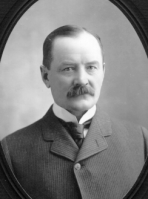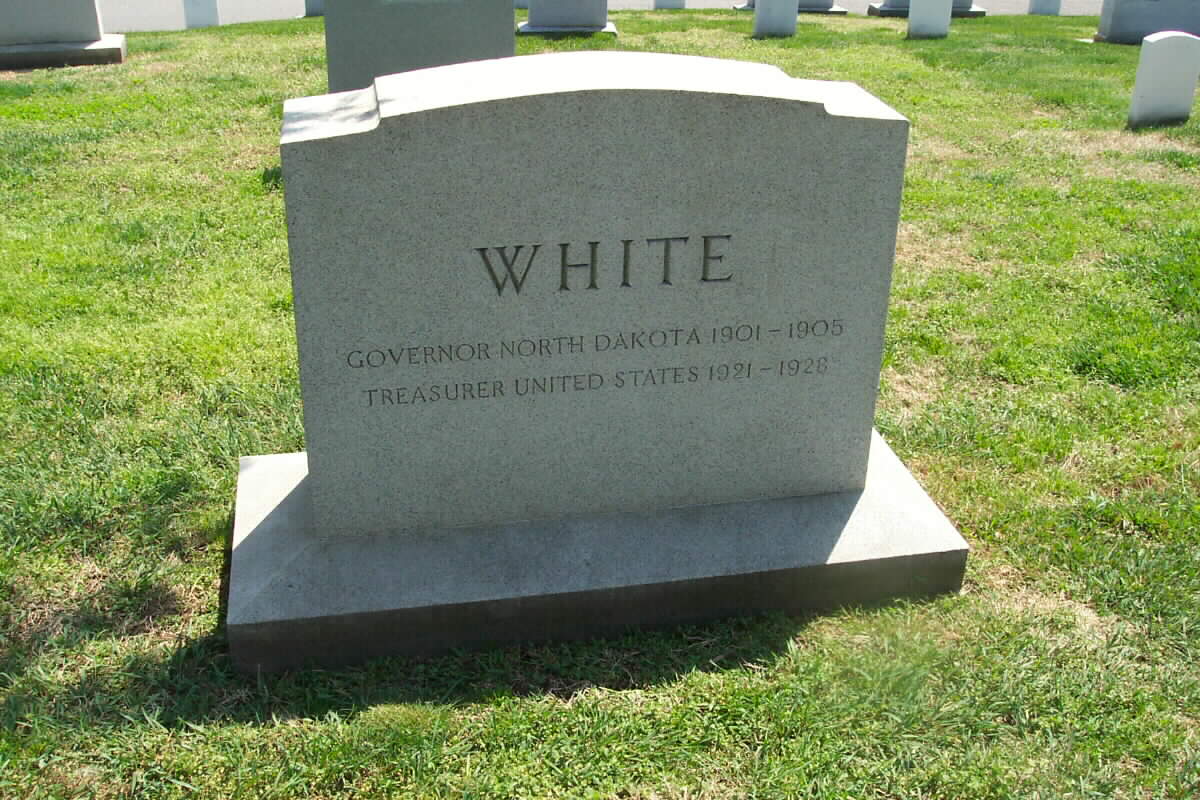Colonel Frank Charles White was born on December 12, 1856, in Stillman Valley, Illinois, to Joshua and Lucy Ann (Brown) White. He received a Bachelor of Arts degree in Civil Engineering from the University of Illinois in 1880. Soon after graduation, White worked for the Chicago, Milwaukee & St. Paul Railroad. In 1882, he moved to the Dakota Territory, although his reasons for doing so are unclear. According to the book Barnes County History, White departed for North Dakota at his father’s request to look after land he had acquired near Valley City; Clement Lounsberry’s North Dakota History and People reports that White moved to North Dakota to look after land he himself had purchased. Nevertheless, while White was in Valley City he met Elsie Hadley, a native of Indiana who was a math teacher at Valley City State Normal School. The couple were married on September 19, 1894, in Indianapolis. The couple had one son, Edwin.
White’s interests soon turned toward politics, and in 1890 he was elected to represent District 15 in the North Dakota House of Representatives. He served only one term before being elected to the State Senate in 1892. He was re-elected in 1896, but resigned from this post to become a commissioned major of the First North Dakota Volunteer Infantry, Spanish-American War.
White arrived in the Philippines on July 30, 1898, participating in the capture of Manila on August 13. Throughout his service in the war, White participated in over twenty engagements, was a highly respected leader, and was awarded the Silver Star for bravery during combat.
White returned to the United States in 1899, and purchased land near Litchville. In 1900, he opened a real estate and insurance office. That same year, he received the Republican nomination for Governor, and was victorious in the fall election.
Under White’s two-term governorship, many needed reforms were implemented. A large amount of the school funds were not drawing interest, and White decided to invest the money in bonds and farm loans, earning interest in the lump sum. It was during his administration that North Dakota’s first state bonds were redeemed. In fact, through his sound financial maneuvering, a $223,000 state deficit was eliminated.
In January 1905, however, White decided to retire from political office to return to private business. He organized the Middlewest Fire Insurance Company and served as its president until 1913, when the company merged with Twin City Fire Insurance Company. In 1914, White organized the Middlewest Loan & Trust Company and was its president until America’s entry into World War I.
With the advent of World War I, White was commissioned once more, this time at the rank of colonel. He commanded the Second North Dakota National Guard Regiment, which later merged into the 41st Infantry Division. In 1918, he was sent to France, but due to his age he was not assigned to combat duty.
When the war ended, White returned to take up his position in Middlewest Loan & Trust Company. His career in politics was not finished, though, for in 1921 White was named United States Treasurer at the request of President Warren G. Harding. When Calvin Coolidge became President in 1924, he was asked to remain in the position. He resigned in May 1928 to become president of Southern Mortgage Guaranty Corporation at Chattanooga, Tennessee.
Elsie White died on July 13, 1925, in Washington, DC. Colonel Frank White died in Washington, D.C. on March 23, 1940. He is buried in Arlington National Cemetery, Arlington, Virginia.
Residence: Valley City, Barnes County
Years Served: 1901-1905
Date of Inauguration: January 10, 1901
Age at Inauguration: 44
Politics: Republican
Born: Stillman Valley, Illinois – December 12, 1856
Died: Washington, D.C. – March 23, 1940
Political Background:
1890: North Dakota State House of Representatives
1892: North Dakota State Senate
1901-1905: Governor of North Dakota
1915-1917: North Dakota State Board of Regents
1921-1928: Treasurer of the United States
Born in Illinois in 1856, Frank White was active in Republican politics most of his life. Serving in both the Spanish-American War and World War I, White was descended from Revolutionary War participants on both sides of his family. He received a bachelor’s degree in civil engineering at the University of Illinois in 1880. He was awarded the Doctor of Laws degree from the same University in 1904, during his second term as governor of North Dakota.
White came to Valley City in 1882. He purchased land from the Northern Pacific Railroad and began farming. He joined the North Dakota National Guard soon after arriving in the state, and served as Captain of Company G.
When the Spanish-American War began, White resigned from the North Dakota State Senate and sold his farm. He was commissioned a major in the First North Dakota Volunteers. He served in the Philippines, and participated in the capture of Manila. He was highly respected as a leader and was awarded the Silver Star for
bravery during combat.
After returning to civilian life in 1899, White purchased a new farm, this time near Litchville. In addition to farming, he was active in insurance and real estate, as well as politics.
White served two terms as governor of the state. The north wing of the old capitol was constructed during his administration. A $223,000 state deficit was eliminated during his term, and a sinking fund was created to pay the bonded debt.
After serving as governor, White returned to private business. He organized the Middlewest Fire Insurance Company and served as its president until 1913. In 1914 he organized the Middlewest Trust Company and served as president until the American entry into World War I.
White reentered active military service during the war. He commanded the Second North Dakota National Guard Regiment which later merged into the 41st Infantry Division. He was sent overseas in 1918. Due to his age, he was not assigned to combat duty. After the war, White returned to work as president of Middlewest
Trust Company. However, he was still not finished with public service.
In 1921 Frank White was named U.S. treasurer by President Warren G. Harding. He succeeded Treasurer John Burke (who had also served as governor of North Dakota from 1907-1913). When Calvin Coolidge became president in 1924, he asked White to remain as treasurer.
White resigned as treasurer of the United States in 1928 to become president of Southern Mortgage Guaranty Corporation at Chattanooga, Tennessee. He continued to be active in business until he retired.
Frank White was the first North Dakota governor to serve two terms. He was active in farming, insurance, and banking. Frank White served as treasurer of the United States from 1921 to 1928.
Colonel White was buried with full military honors in Arlington National Cemetery. His son, Edwin Lee White, Colonel, United States Air Force, is buried next to him.
Frank White (1856-1940) Born December 12, 1856. Governor of North Dakota, 1901-05. Died March 23, 1940. Interment at Arlington National Cemetery, Arlington, Virginia.
1921: former Governor Frank White became Treasurer of the United States, a position he held until 1928.
WHITE, FRANK
- COL INF US ARMY
- DATE OF DEATH: 03/23/1940
- BURIED AT: SECTION 4 SITE 3239
ARLINGTON NATIONAL CEMETERY
WHITE, ELSIE HADLEY W/O FRANK
- DATE OF DEATH: 07/13/1925
- BURIED AT: SECTION D SITE 3239
- ARLINGTON NATIONAL CEMETERY
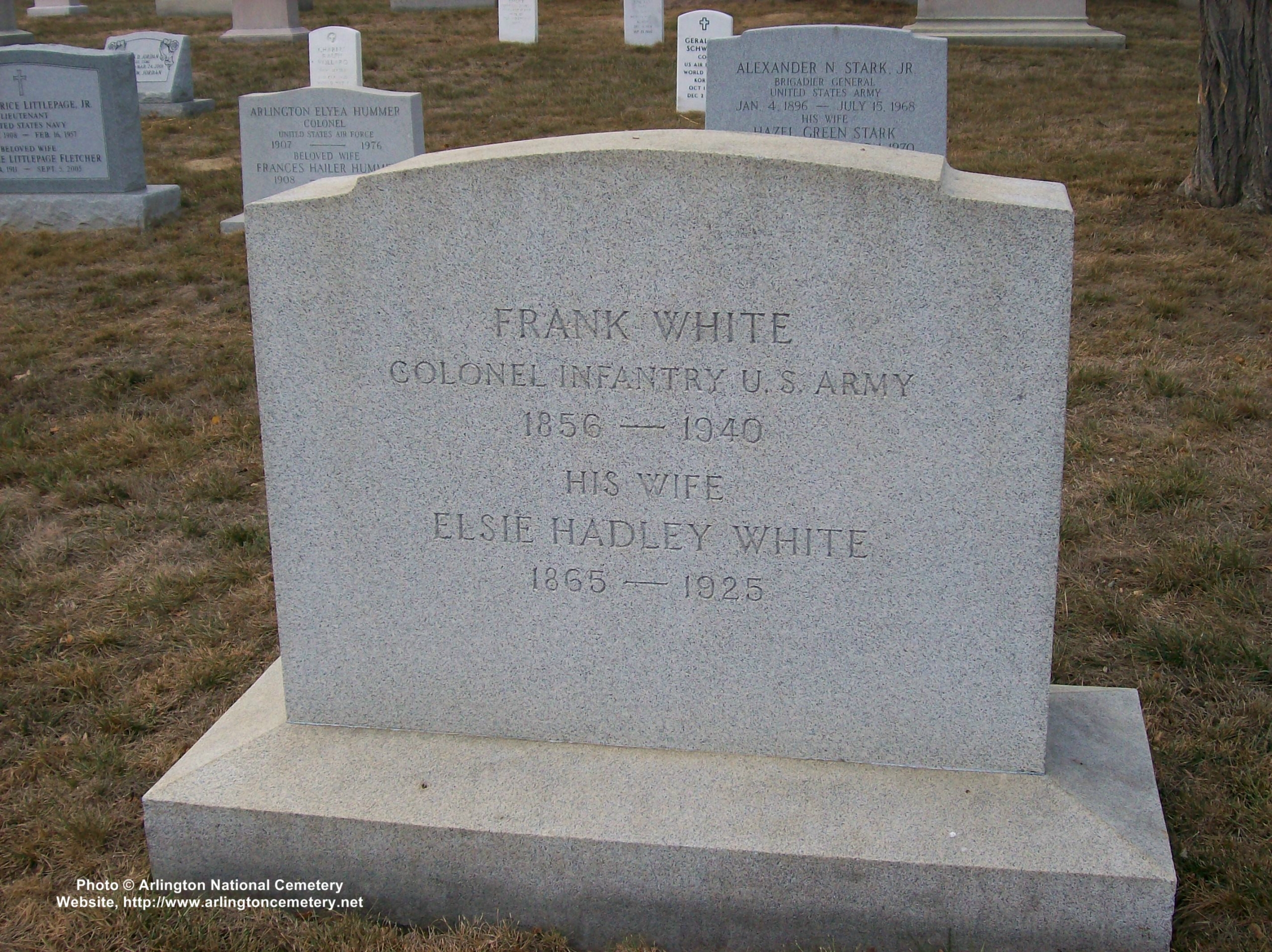
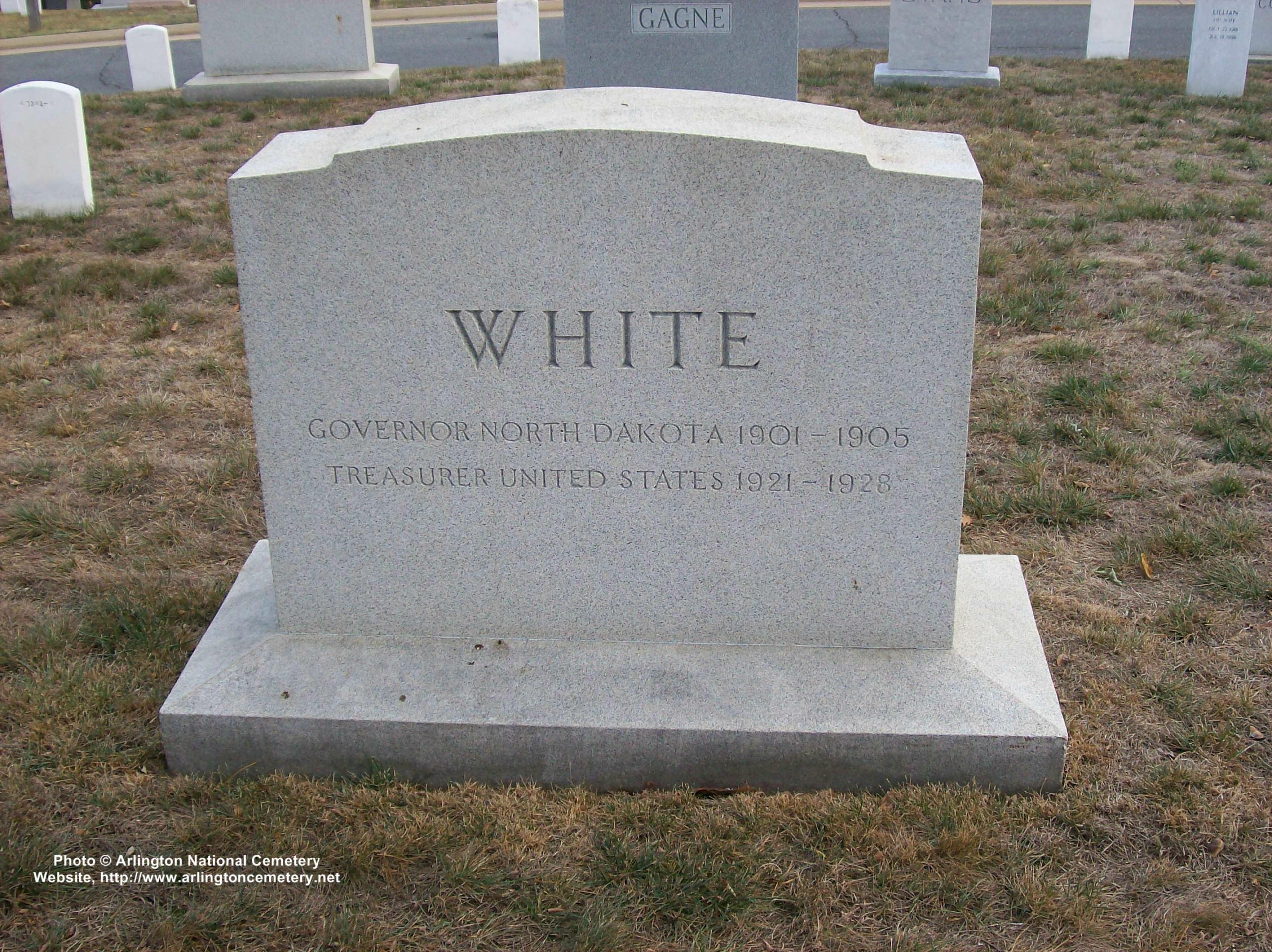
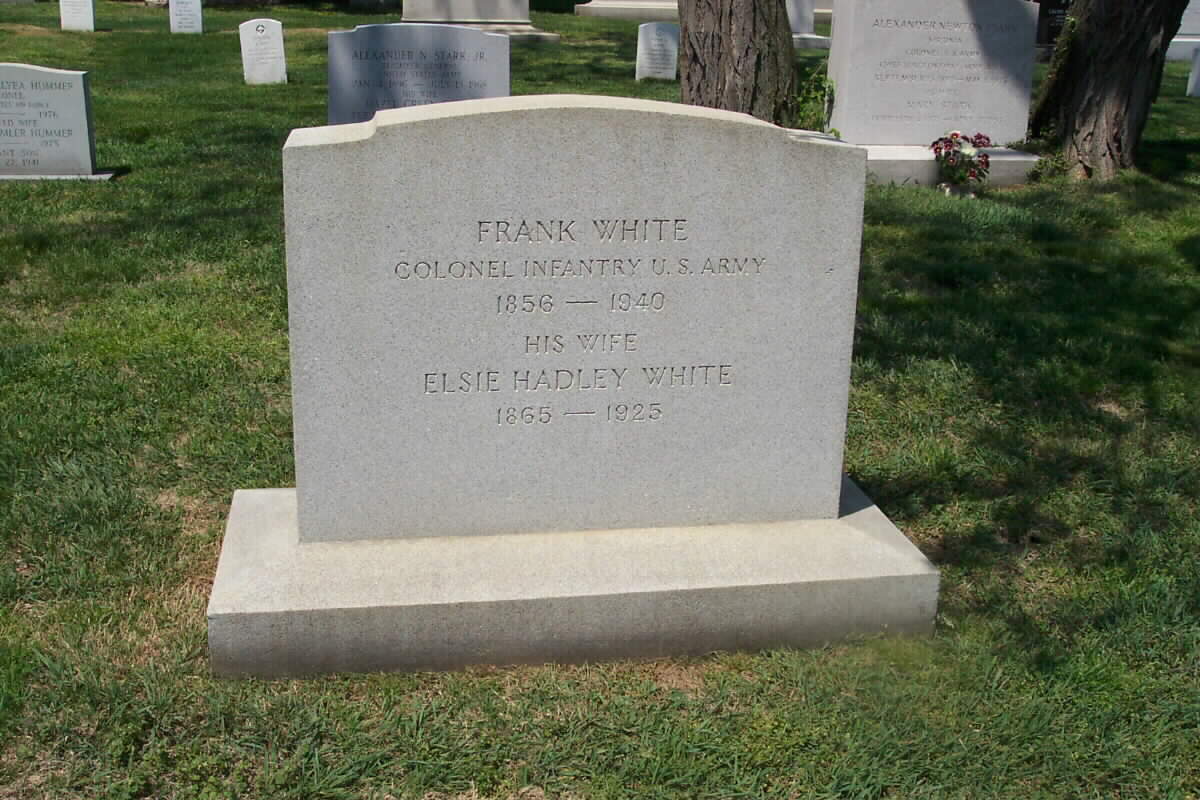
Michael Robert Patterson was born in Arlington and is the son of a former officer of the US Army. So it was no wonder that sooner or later his interests drew him to American history and especially to American military history. Many of his articles can be found on renowned portals like the New York Times, Washingtonpost or Wikipedia.
Reviewed by: Michael Howard

